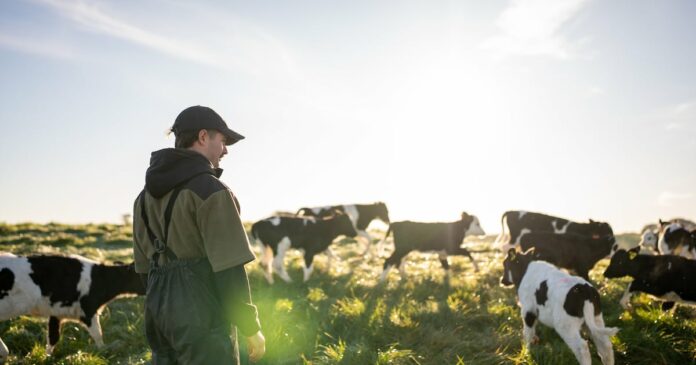A recent study conducted by the Curtin University Sustainability Policy Institute in Perth sheds light on the challenges faced by Australian farmers in the dairy industry. The research surveyed 147 farmers to explore their attitudes towards the industry and their willingness to transition to other forms of farming.
The findings revealed that more than half of the farmers surveyed expressed dissatisfaction with dairy farming, citing concerns such as rising operational costs, labor shortages, and work-life balance issues. Financial constraints resulting from high input costs and fluctuating milk prices were identified as key factors impacting farmers’ ability to invest in infrastructure, labor, and animal health.
Climate change uncertainty was also highlighted as a significant challenge, with only a third of farmers recognizing its impact on their business models. Professor Clive Phillips, co-author of the study, emphasized the need for greater awareness of the link between livestock and climate change among farmers.
Mental health emerged as a critical issue, with two-thirds of farmers reporting negative impacts on their well-being due to farm-related challenges. Suicide rates among farmers were found to be 60% higher compared to non-farmers, with factors such as long working hours, economic hardship, and sector consolidation contributing to poor mental health.
Despite these challenges, over half of the surveyed farmers expressed openness to exploring alternatives to dairy farming. However, profitability, land suitability for other agricultural operations, and familiarity with dairy were cited as barriers to transitioning. While some farmers indicated that government funding could incentivize them to consider alternative ventures, a majority stated that financial support alone would not persuade them to leave the sector.
The study also revealed that financial assistance could help retain farmers in the dairy industry, with a significant proportion expressing a desire to receive support to remain in the sector. Aging, health issues, and labor shortages were identified as key factors influencing farmers’ decisions to explore alternative options, while family ties and a passion for dairy farming played a significant role in those committed to staying in the business.
Diversification emerged as a potential solution for farmers looking to overcome financial challenges, with mixed farming options such as incorporating beef, horticulture, or broadacre farming seen as viable strategies to maintain a stable income. By turning challenges into opportunities and exploring alternative agricultural enterprises, farmers can navigate the complexities of the dairy industry and secure a sustainable future for their operations.
In conclusion, the research underscores the importance of addressing the well-being of farmers, acknowledging the impact of climate change, and exploring diversification as a means to sustain and thrive in the dairy industry. By understanding and responding to the challenges faced by farmers, policymakers and industry stakeholders can support the transition towards a more resilient and prosperous agricultural sector. Climate change poses a significant challenge to the agricultural sector, including dairy farming. While efforts to reduce on-farm emissions are important, research indicates that climate change is not a top concern for dairy farmers in their day-to-day operations. This is despite the fact that agriculture accounts for approximately 16% of Australia’s total greenhouse gas emissions, with dairy farms contributing about 19% of on-farm emissions, totaling around 3% of the nation’s overall emissions.
A study on Australian dairy farmers’ attitudes towards their business and the challenges they face highlighted a lack of awareness among farmers regarding the link between livestock, particularly cattle, and greenhouse gas emissions. The study found that while farmers expressed concerns about climate change uncertainty impacting their businesses, there was little recognition of the significant contribution of cattle to emissions. This lack of understanding could potentially hinder farmers’ interest in transitioning to more sustainable practices or alternative enterprises.
One way to address the environmental impact of dairy farming is by improving soil health and reducing reliance on fertilizers. Implementing practices such as crop rotation, introducing cover crops, and regularly measuring soil nutrients can help mitigate the need for excessive fertilizer use, thereby reducing greenhouse gas emissions associated with agriculture.
It is crucial for dairy farmers to be aware of the environmental implications of their operations and explore sustainable practices that can not only benefit the environment but also improve the long-term viability of their businesses. Transitioning to plant-based choices and diversifying into alternative enterprises could be potential strategies for dairy farmers to reduce their environmental footprint and adapt to changing market demands.
The findings of the study underscore the importance of raising awareness among dairy farmers about the link between livestock, greenhouse gas emissions, and the potential benefits of transitioning to more sustainable practices. By incorporating environmentally friendly practices into their operations, dairy farmers can contribute to mitigating climate change and ensuring the long-term sustainability of the agricultural sector.
In conclusion, while climate change may not be a top concern for dairy farmers in their day-to-day business operations, it is essential for them to recognize the impact of their practices on the environment. By adopting sustainable practices, such as improving soil health and transitioning to alternative enterprises, dairy farmers can play a significant role in reducing greenhouse gas emissions and building a more resilient and environmentally friendly agricultural sector.




